Perennials are often referred to as the “busy gardener’s favorites” because they make unnecessary the sowing of seeds or the setting out of transplants every year. A perennial is in the garden for at least two years and most for much longer. Perennials, especially in their flowering habit, offer the gardener many advantages.
Added advantage: some perennials bloom for an exceptionally long time–as long as two months, nearly a full season. If beauty is essential and your time is short, consider adding long-blooming perennials to the garden.
Here’s our list of 20 perennials that you can count on to bloom for 6 to 8 weeks. And if you cut back or deadhead these perennials after each flush of flowers, you will almost certainly get additional weeks of bloom. Click on the botanical name for each in red to get how-to-grow tips for each.
Perennials for 6 to 8 weeks of bloom
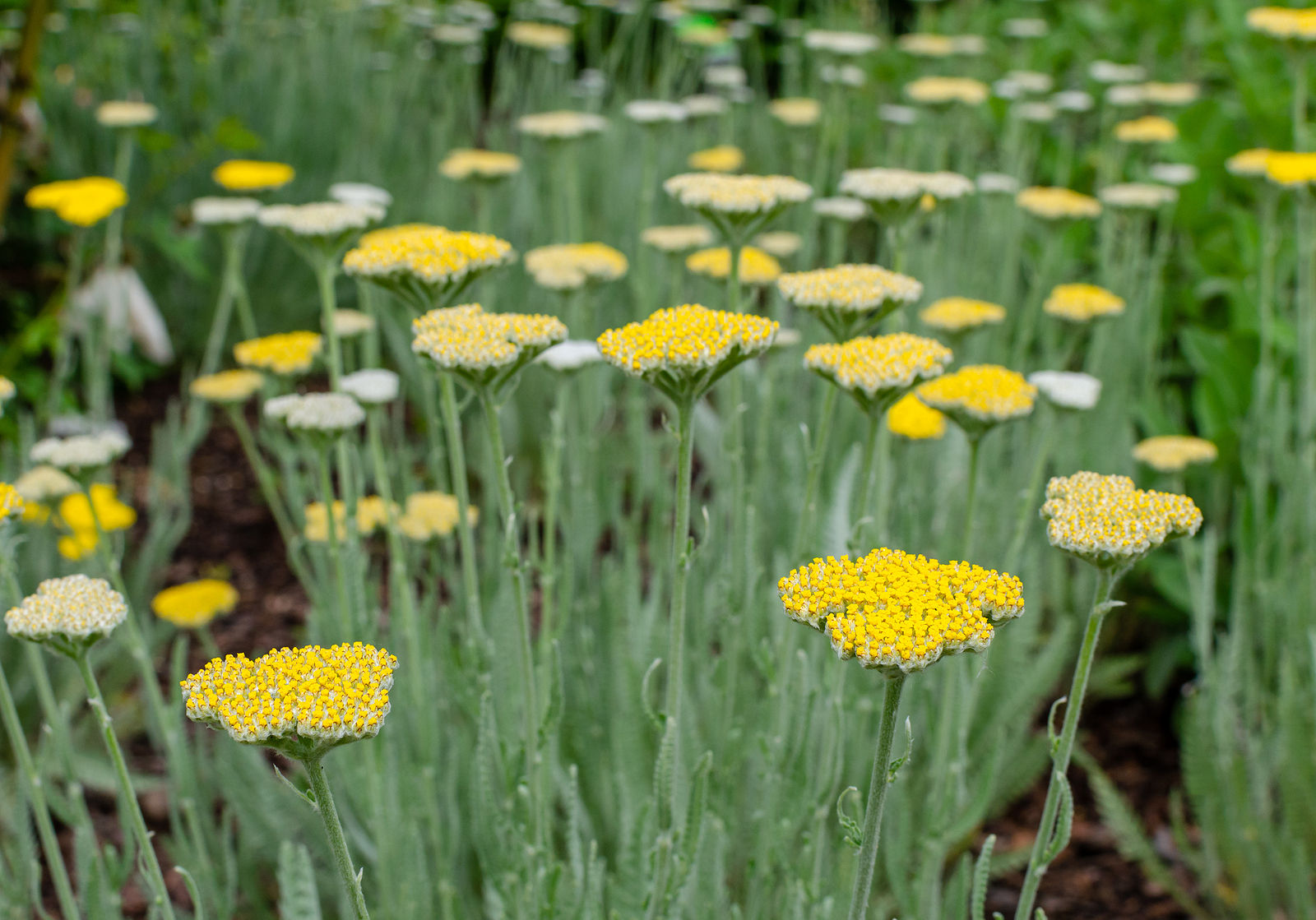 Achillea, commonly called yarrow, thrives in hot, dry, sunny gardens. Showy flat-topped flowers appear in late spring or early summer and hold their color for weeks. Best in Zones 3 to 9; plant in full sun; grows to 24 inches (61cm) tall. Varieties to try include hybrids ‘Coronation Gold’ (fern-leaf yarrow) and ‘Moonshine’ (moonshine yarrow).
Achillea, commonly called yarrow, thrives in hot, dry, sunny gardens. Showy flat-topped flowers appear in late spring or early summer and hold their color for weeks. Best in Zones 3 to 9; plant in full sun; grows to 24 inches (61cm) tall. Varieties to try include hybrids ‘Coronation Gold’ (fern-leaf yarrow) and ‘Moonshine’ (moonshine yarrow).
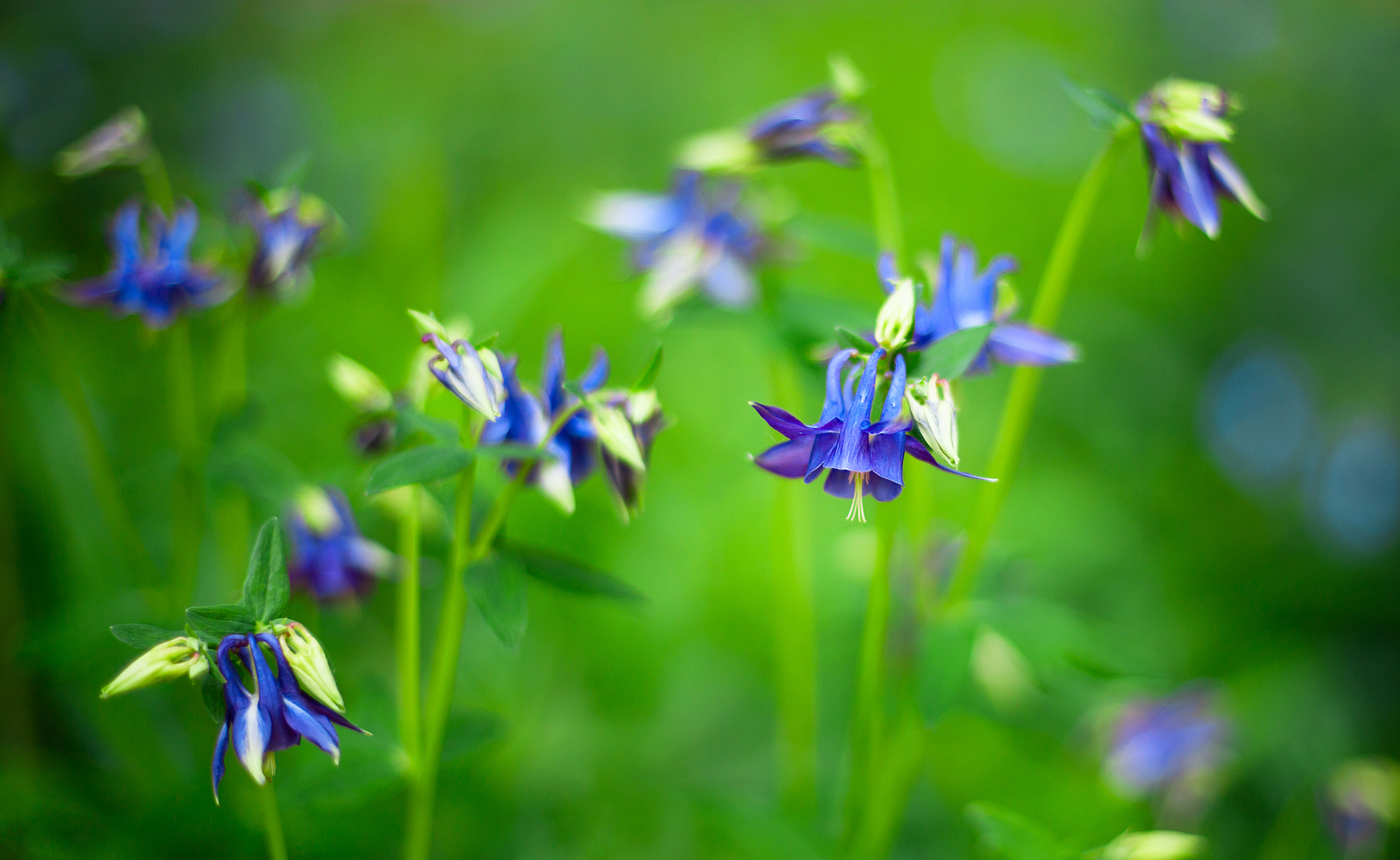 Aquilegia X hybrida, commonly called columbine, is a staple of perennial borders and cottage gardens. Nodding flowers appear in early summer. Best in Zones 3 to 9; plant in full sun or part shade and moist, well-drained soil; grows 12 to 18 inches (30-45cm) tall. Varieties to grow include ‘McKana Hybrids’.
Aquilegia X hybrida, commonly called columbine, is a staple of perennial borders and cottage gardens. Nodding flowers appear in early summer. Best in Zones 3 to 9; plant in full sun or part shade and moist, well-drained soil; grows 12 to 18 inches (30-45cm) tall. Varieties to grow include ‘McKana Hybrids’.
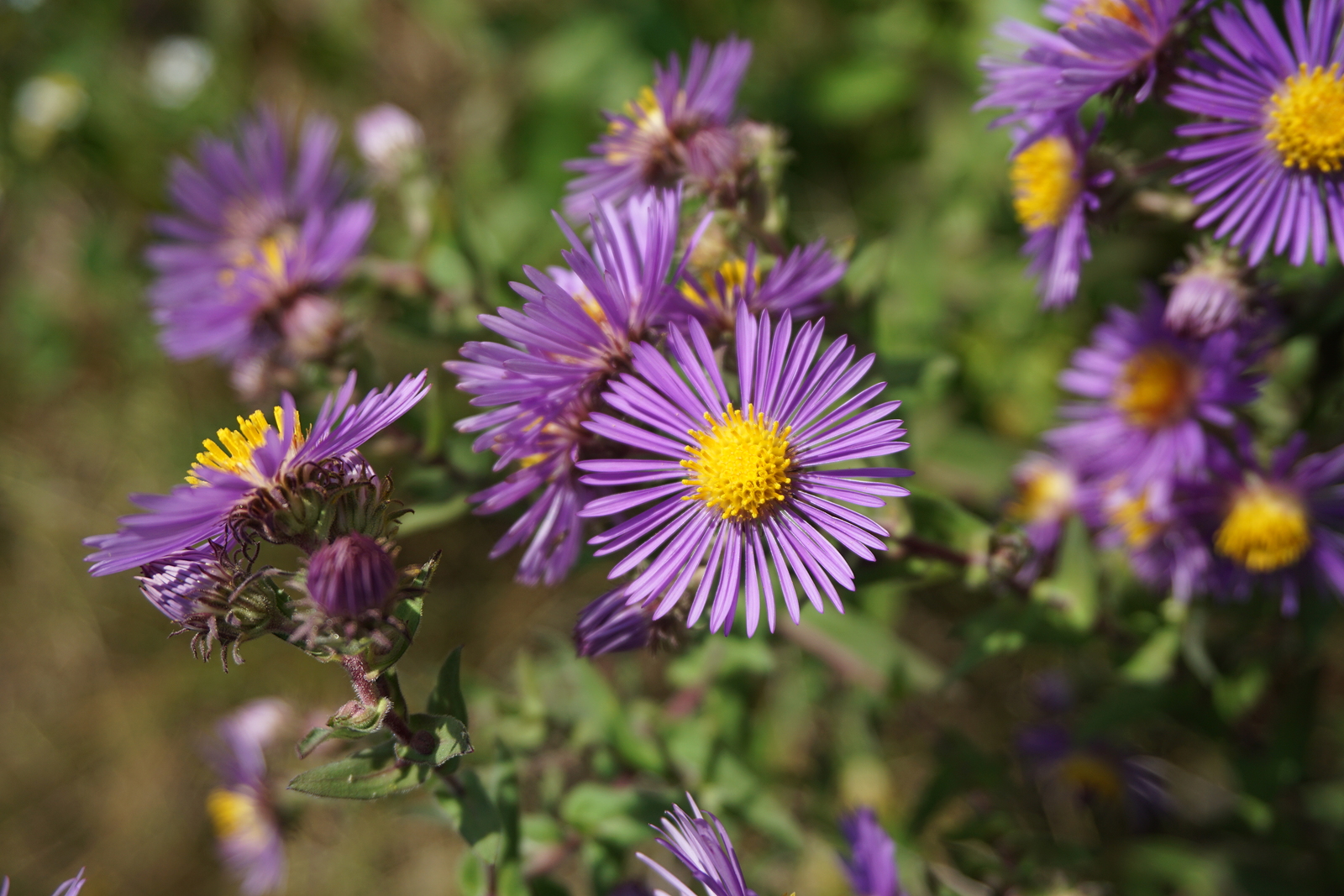 Aster novae-angliae, commonly called New England aster, adds color to the late summer and fall garden. Daisylike New England asters appear in white and shades of violet and pink. Best in Zones 4 to 8; plant in full sun; grows 10 inches to 4 feet tall depending on cultivar. Cultivar ‘Alma Potschke’ (Michaelmas daisy) has rose-pink flowers and grows 3 to 4 feet (1-1.2m) tall.
Aster novae-angliae, commonly called New England aster, adds color to the late summer and fall garden. Daisylike New England asters appear in white and shades of violet and pink. Best in Zones 4 to 8; plant in full sun; grows 10 inches to 4 feet tall depending on cultivar. Cultivar ‘Alma Potschke’ (Michaelmas daisy) has rose-pink flowers and grows 3 to 4 feet (1-1.2m) tall.
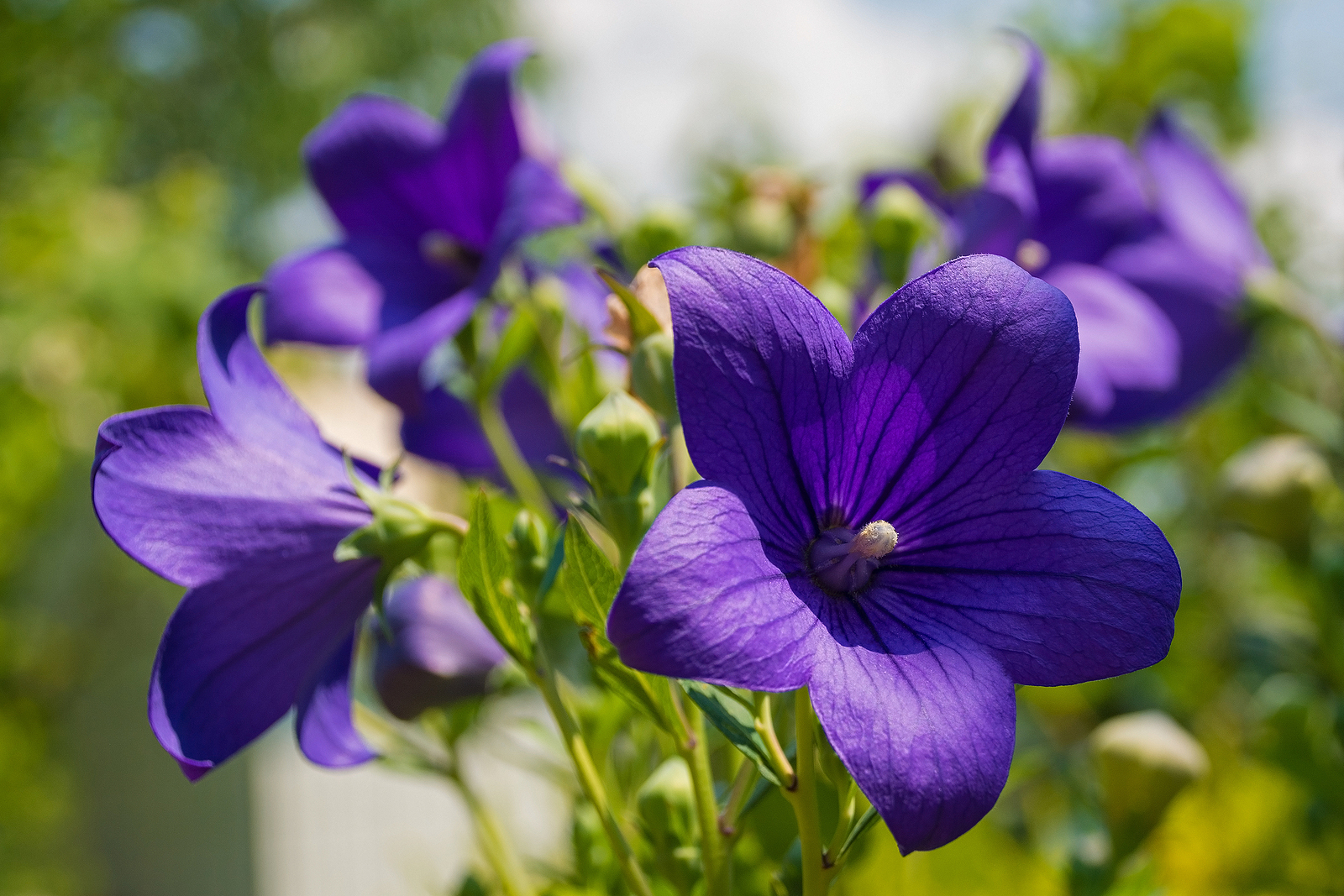 Campanula carpatica, commonly called Carpathian bellflower, is a compact, ground-hugging bellflower that grows 6 to 12 inches (15-30cm) tall and is well suited for edge planting and rock gardens. Best in Zones 3 to 8; plant in full or partial shade and moist, well-drained soil. Varieties to plant include ‘Blue Chips’ and ‘White Chips’ with long-lasting, upturned flowers.
Campanula carpatica, commonly called Carpathian bellflower, is a compact, ground-hugging bellflower that grows 6 to 12 inches (15-30cm) tall and is well suited for edge planting and rock gardens. Best in Zones 3 to 8; plant in full or partial shade and moist, well-drained soil. Varieties to plant include ‘Blue Chips’ and ‘White Chips’ with long-lasting, upturned flowers.
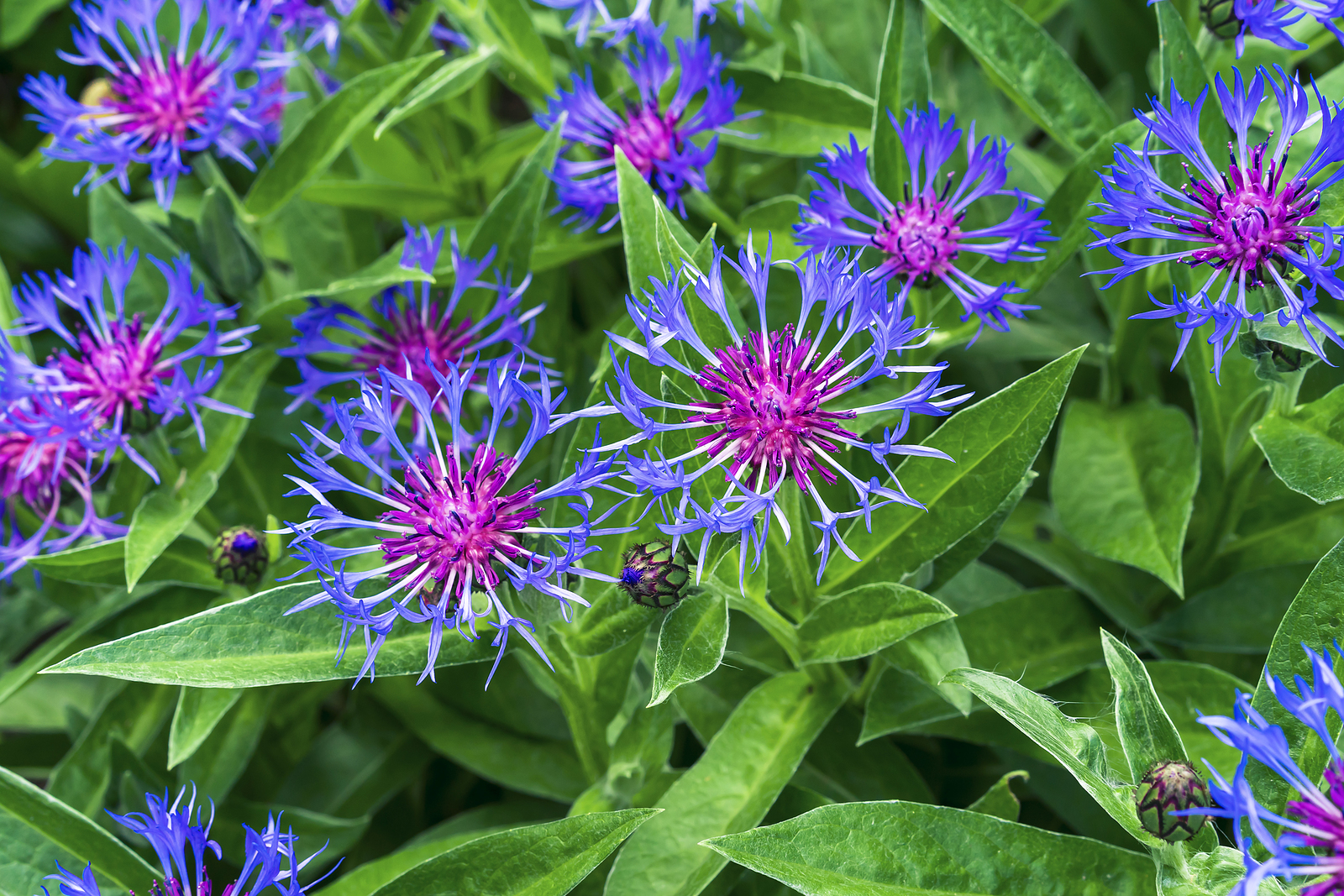 Centaurea montana, commonly called mountain bluet, blooms in early to mid-summer. Plants grow into mounds 12 to 24 inches (30-61cm) tall. Mountain bluet is tolerant of a variety of soils and grows in full sun or part shade and well-drained soil. Best in Zones 3 to 8. Cultivars include ‘Alba’ with white blooms, ‘Carnea’ with pink flowers, and ‘Violetta’ with dark violet flowers.
Centaurea montana, commonly called mountain bluet, blooms in early to mid-summer. Plants grow into mounds 12 to 24 inches (30-61cm) tall. Mountain bluet is tolerant of a variety of soils and grows in full sun or part shade and well-drained soil. Best in Zones 3 to 8. Cultivars include ‘Alba’ with white blooms, ‘Carnea’ with pink flowers, and ‘Violetta’ with dark violet flowers.
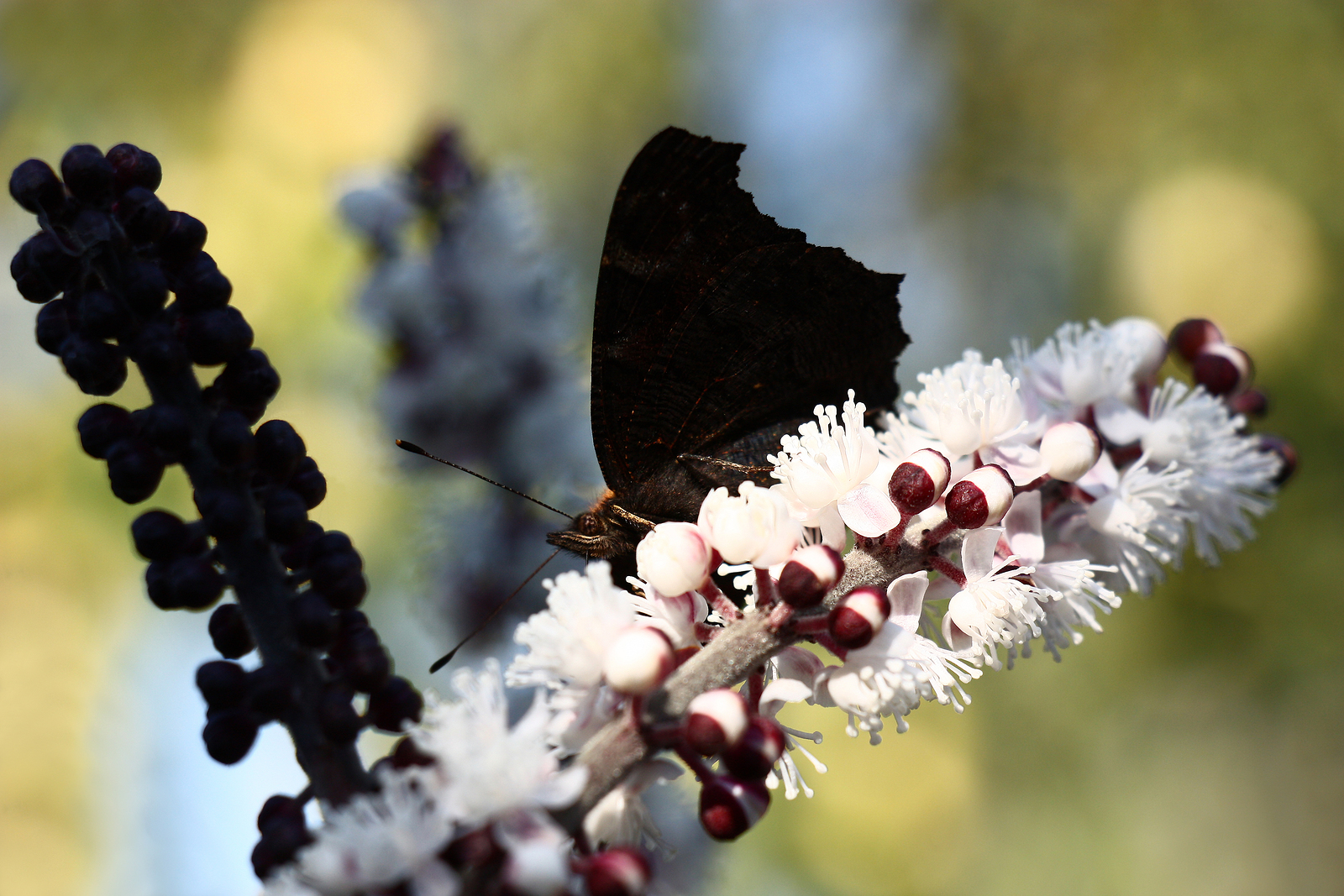 Cimicifuga spp., commonly called bugbane, has dense white flowers that tower to nearly 6 feet tall making it an excellent focal point for woodland and shade gardens. Best in Zones 3 to 8; plant in part or full shade and moist soil. Cultivars ‘Brunette’ has bronze-colored leaves and ‘Atroperpurea’ had dark purple leaves when young turning green with purple veins later.
Cimicifuga spp., commonly called bugbane, has dense white flowers that tower to nearly 6 feet tall making it an excellent focal point for woodland and shade gardens. Best in Zones 3 to 8; plant in part or full shade and moist soil. Cultivars ‘Brunette’ has bronze-colored leaves and ‘Atroperpurea’ had dark purple leaves when young turning green with purple veins later.
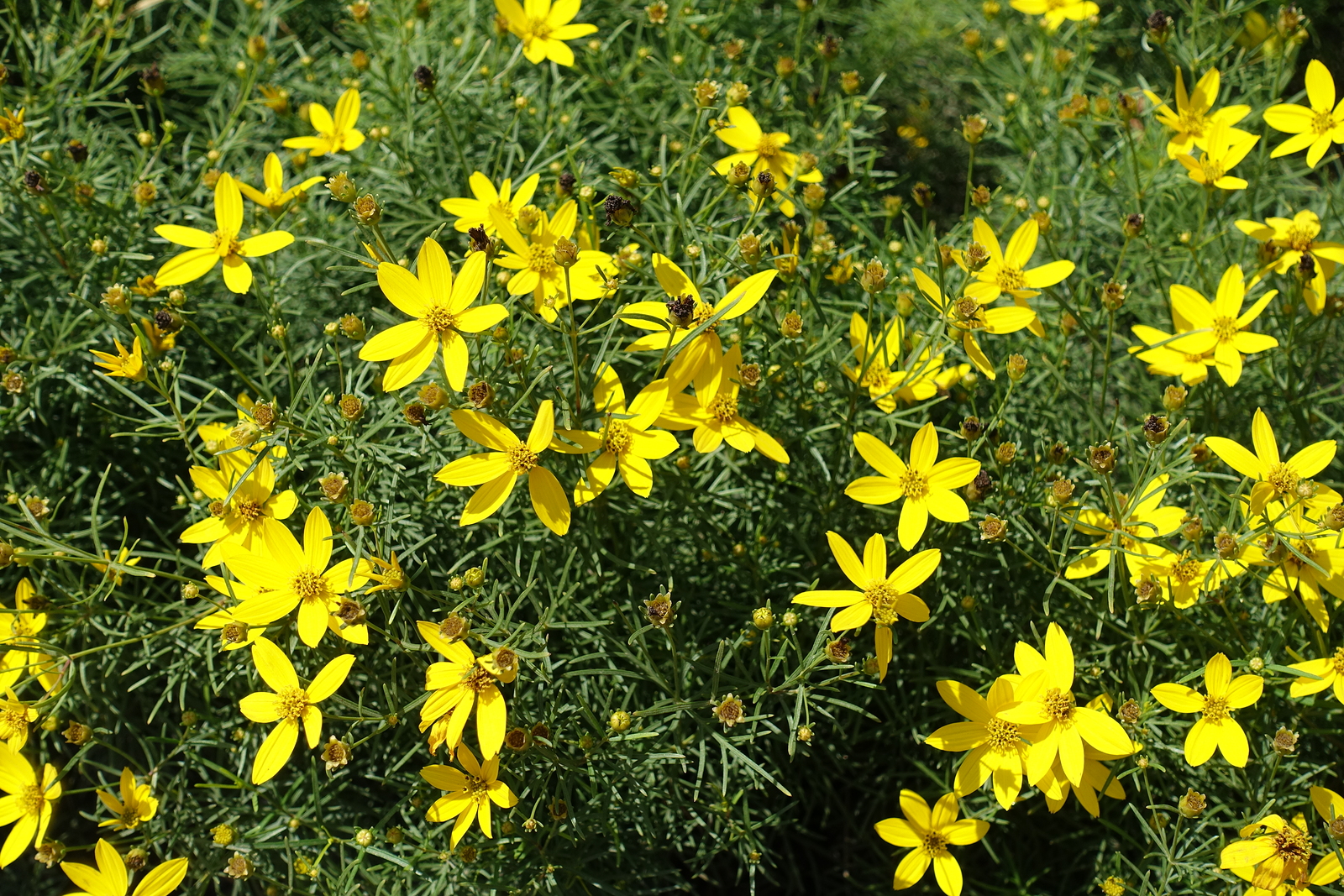 Coreopsis verticillata, commonly called thread-leaved coreopsis, blooms from early summer to fall and will not be stopped by heat or drought. Cultivars ‘Moonbeam’ has creamy-yellow flowers and lacy foliage and grows to 24 inches (61cm) tall; ‘Zagreb’ has bright yellow flowers and grows to 18 inches (45cm) tall. Best in Zones 3 to 8.
Coreopsis verticillata, commonly called thread-leaved coreopsis, blooms from early summer to fall and will not be stopped by heat or drought. Cultivars ‘Moonbeam’ has creamy-yellow flowers and lacy foliage and grows to 24 inches (61cm) tall; ‘Zagreb’ has bright yellow flowers and grows to 18 inches (45cm) tall. Best in Zones 3 to 8.
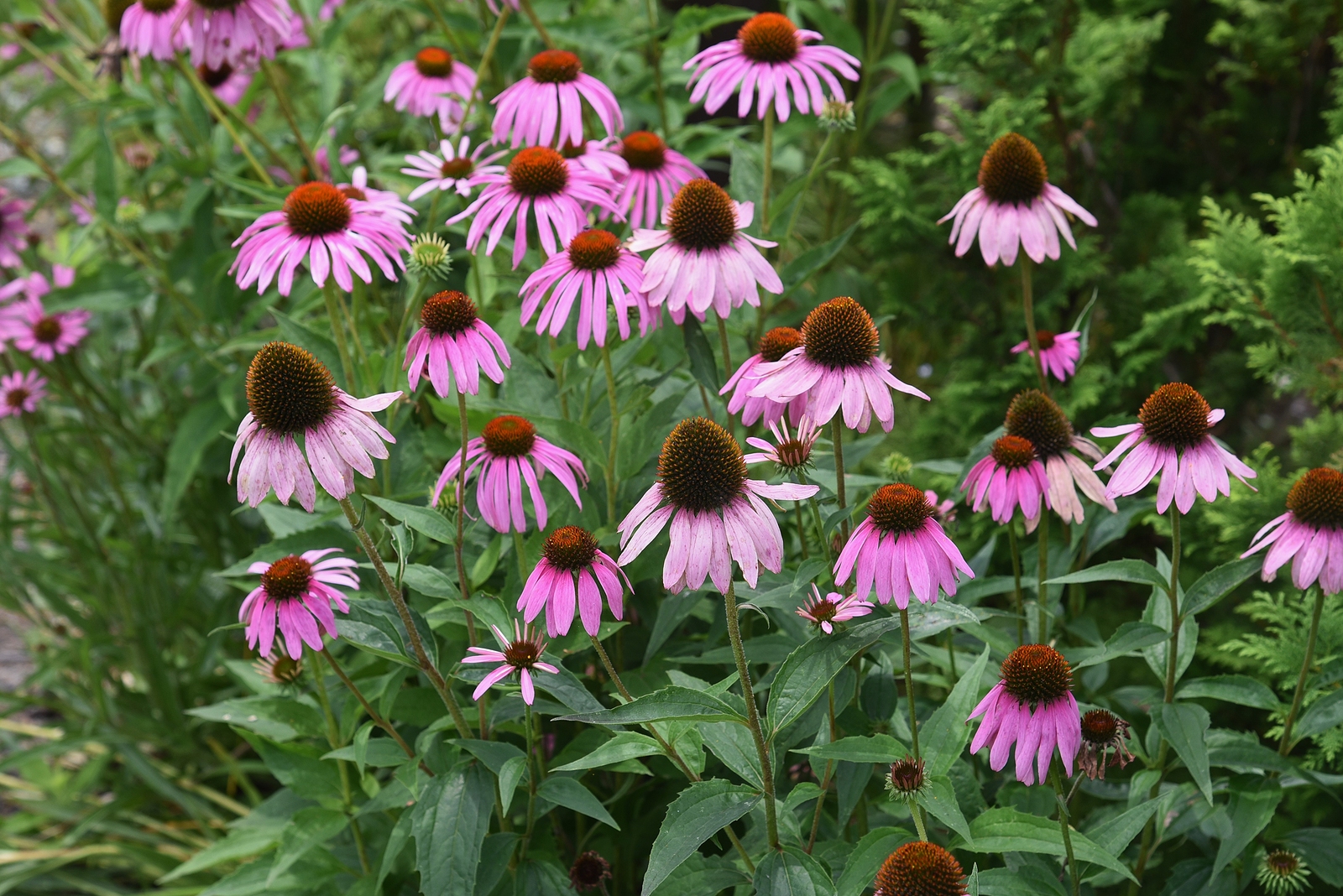 Echinacea purpurea, commonly called purple coneflower, has daisylike flowers that are usually purple; white, pink, red, yellow, and orange cultivars are available. Best in Zones 3 to 8; plant in full sun and well-drained soil; in hot regions the color is more intense in light shade. Cultivar ‘Bright Star’, ‘Crimson Star’, and ‘Ruby Star’ have large red flowers.
Echinacea purpurea, commonly called purple coneflower, has daisylike flowers that are usually purple; white, pink, red, yellow, and orange cultivars are available. Best in Zones 3 to 8; plant in full sun and well-drained soil; in hot regions the color is more intense in light shade. Cultivar ‘Bright Star’, ‘Crimson Star’, and ‘Ruby Star’ have large red flowers.
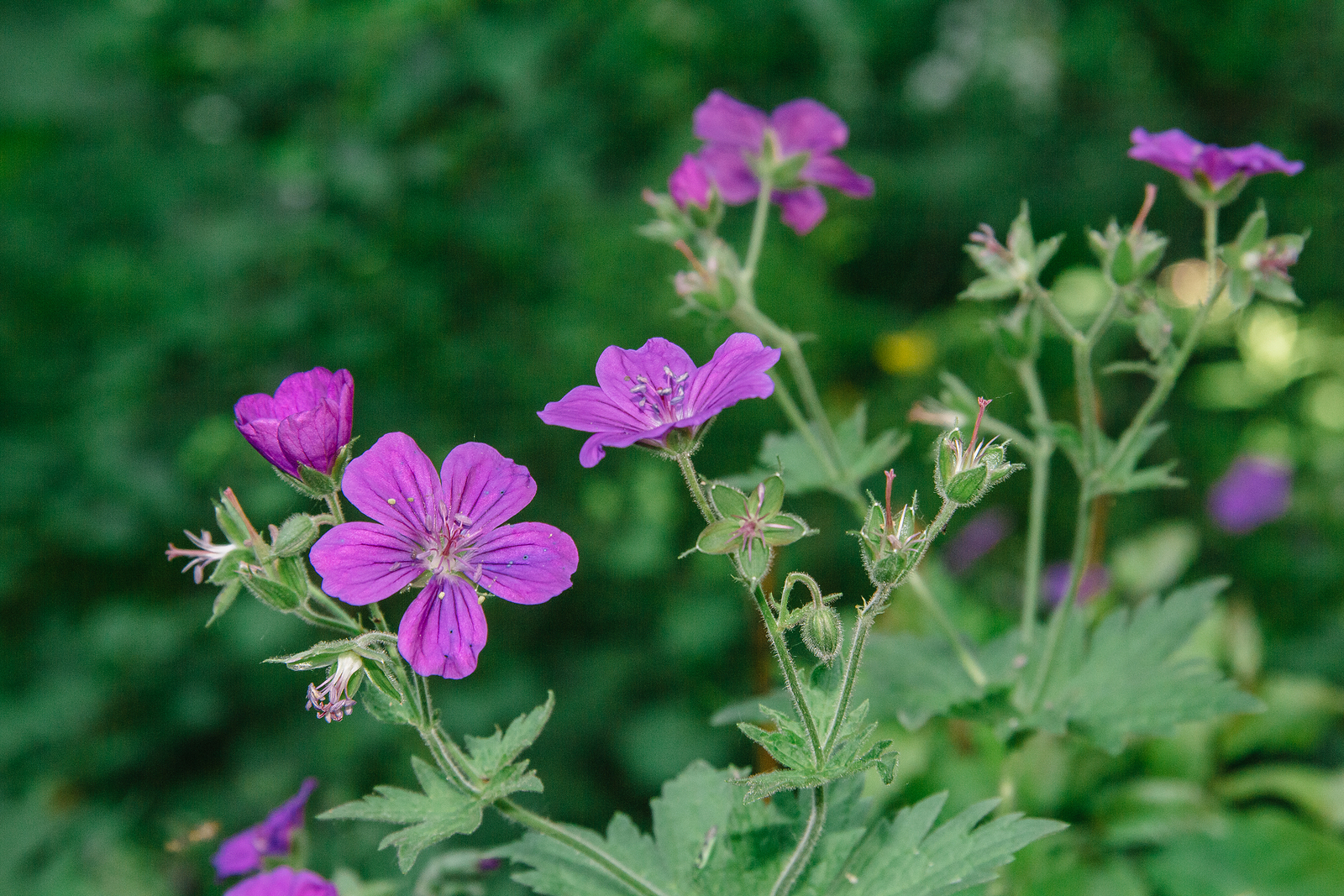 Geranium species and hybrids, commonly called cranesbill, bloom from late spring to early summer and then bloom sporadically during the rest of the growing season. They bear dainty, mostly single flowers and should not be confused with the common geranium (Pelargonium). Flower colors range from white to pink to magenta and purple. Grows best in Zones 4 to 8; plant in full sun or part shade and moist, well-drained, humus-rich soil; plants grow 12 to 20 inches (30-50cm) tall. Try G. endressii ‘Wargrave Pink’, G. X ‘Johnson’s Blue’, and G. sanguineum, known as bloody cranesbill.
Geranium species and hybrids, commonly called cranesbill, bloom from late spring to early summer and then bloom sporadically during the rest of the growing season. They bear dainty, mostly single flowers and should not be confused with the common geranium (Pelargonium). Flower colors range from white to pink to magenta and purple. Grows best in Zones 4 to 8; plant in full sun or part shade and moist, well-drained, humus-rich soil; plants grow 12 to 20 inches (30-50cm) tall. Try G. endressii ‘Wargrave Pink’, G. X ‘Johnson’s Blue’, and G. sanguineum, known as bloody cranesbill.
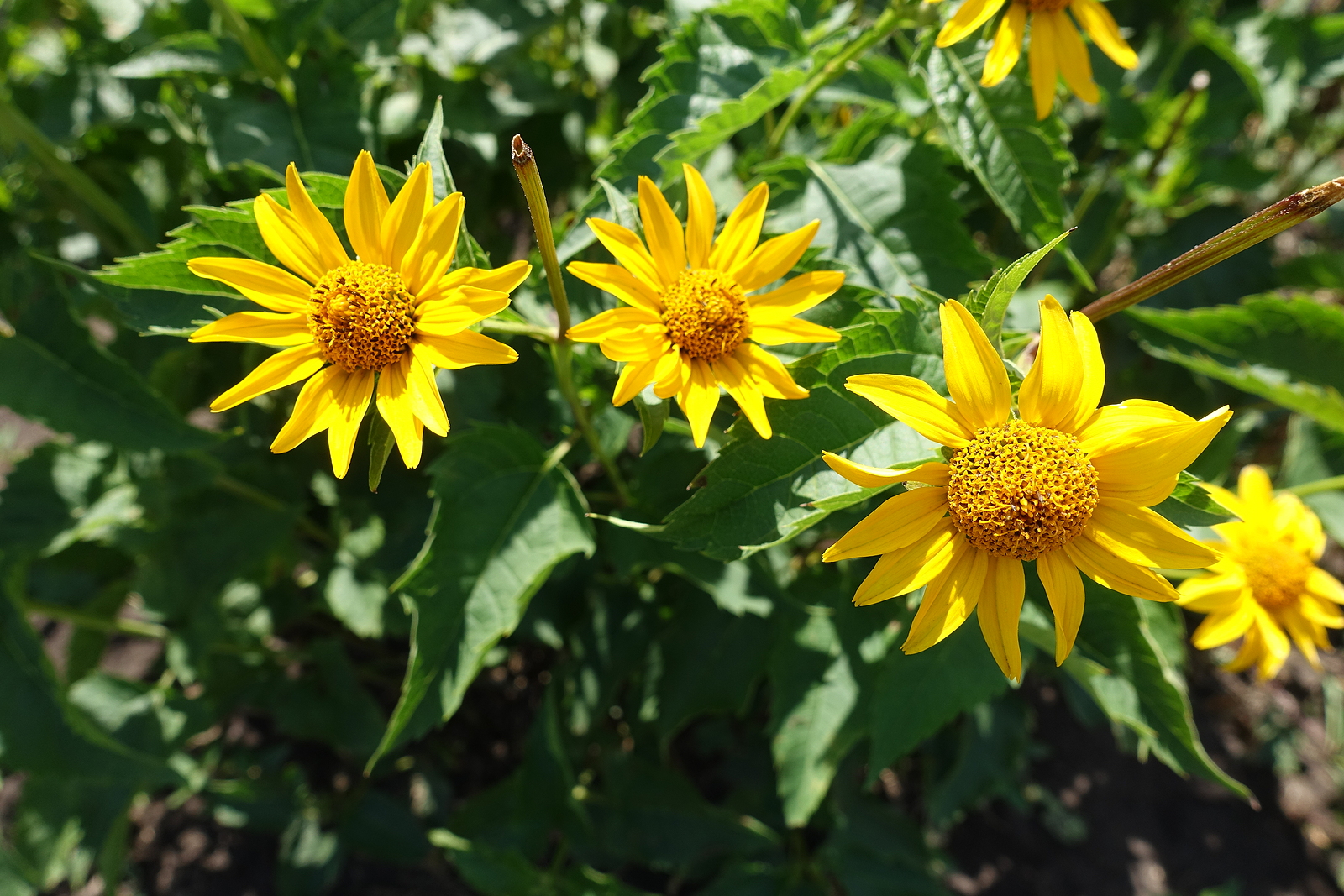 Heliopsis helianthoides, commonly called false sunflower, bears double or semi-double flowers on long stems in late summer. Heliopsis is an excellent cutting flower. Best in Zones 4 to 8; grow in average garden soil in full sun; plants multiply rapidly and will need frequent division. Cultivars include ‘Golden Plume’ with double, yellow flowers and green centers, and ‘Summer Sun’ with double, bright yellow flowers.
Heliopsis helianthoides, commonly called false sunflower, bears double or semi-double flowers on long stems in late summer. Heliopsis is an excellent cutting flower. Best in Zones 4 to 8; grow in average garden soil in full sun; plants multiply rapidly and will need frequent division. Cultivars include ‘Golden Plume’ with double, yellow flowers and green centers, and ‘Summer Sun’ with double, bright yellow flowers.
 Helleborus niger, commonly called Christmas rose because its blooming season often begins before the holidays and extends through and beyond them, and also because the flower resembles a single rose. Plant Christmas rose from late summer until winter and in early spring. It is most likely that Christmas rose will bloom during mild periods when the snow has left the ground. They commonly bloom when no other plants are blooming. The white flowers are borne on either simple or one-branched stems about 12 inches (33cm) high so the flowers are elevated above the leaves. Another variety of Helleborus, Helleborus orientalis, is known as the Lenten rose—it blooms in spring. Best in Zones 4-8.
Helleborus niger, commonly called Christmas rose because its blooming season often begins before the holidays and extends through and beyond them, and also because the flower resembles a single rose. Plant Christmas rose from late summer until winter and in early spring. It is most likely that Christmas rose will bloom during mild periods when the snow has left the ground. They commonly bloom when no other plants are blooming. The white flowers are borne on either simple or one-branched stems about 12 inches (33cm) high so the flowers are elevated above the leaves. Another variety of Helleborus, Helleborus orientalis, is known as the Lenten rose—it blooms in spring. Best in Zones 4-8.
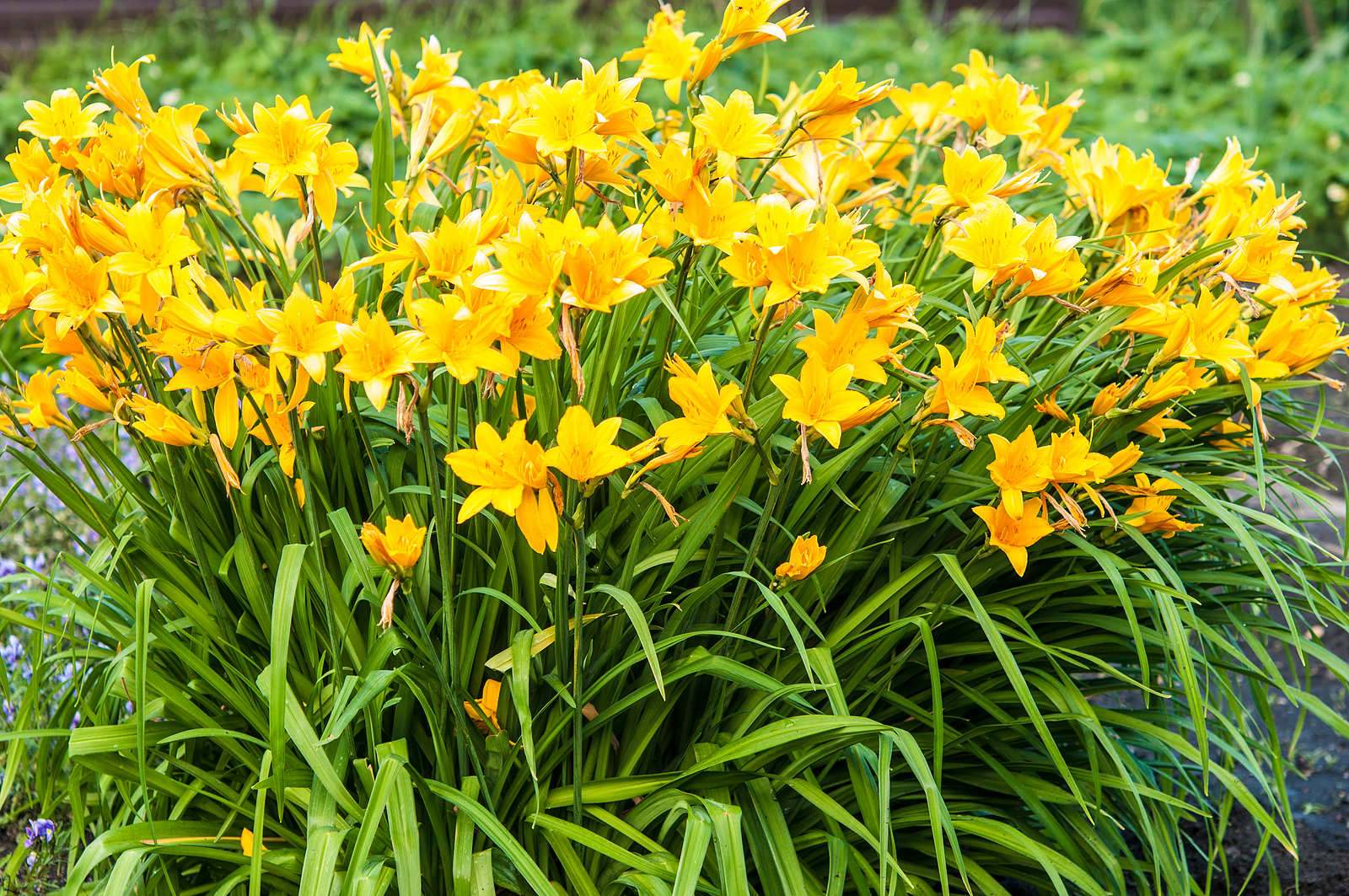 Hemerocallis hybrids, commonly called daylily, bear large, trumpet blooms, some lasting just a day but blooms from the same plant appear again and again. Flowers are often yellow or orange, but there are many color variations. The daylily is a perennial that has narrow, upright and arching glossy green leaves. Most grow to about 28 inches (70cm) tall. There are about 15 species of evergreen, semi-evergreen, and herbaceous daylilies. From those species come more than 50,000 named cultivars. Many named varieties are registered with the American Hemerocallis Society. Daylilies can be grown in Zones 3-10
Hemerocallis hybrids, commonly called daylily, bear large, trumpet blooms, some lasting just a day but blooms from the same plant appear again and again. Flowers are often yellow or orange, but there are many color variations. The daylily is a perennial that has narrow, upright and arching glossy green leaves. Most grow to about 28 inches (70cm) tall. There are about 15 species of evergreen, semi-evergreen, and herbaceous daylilies. From those species come more than 50,000 named cultivars. Many named varieties are registered with the American Hemerocallis Society. Daylilies can be grown in Zones 3-10
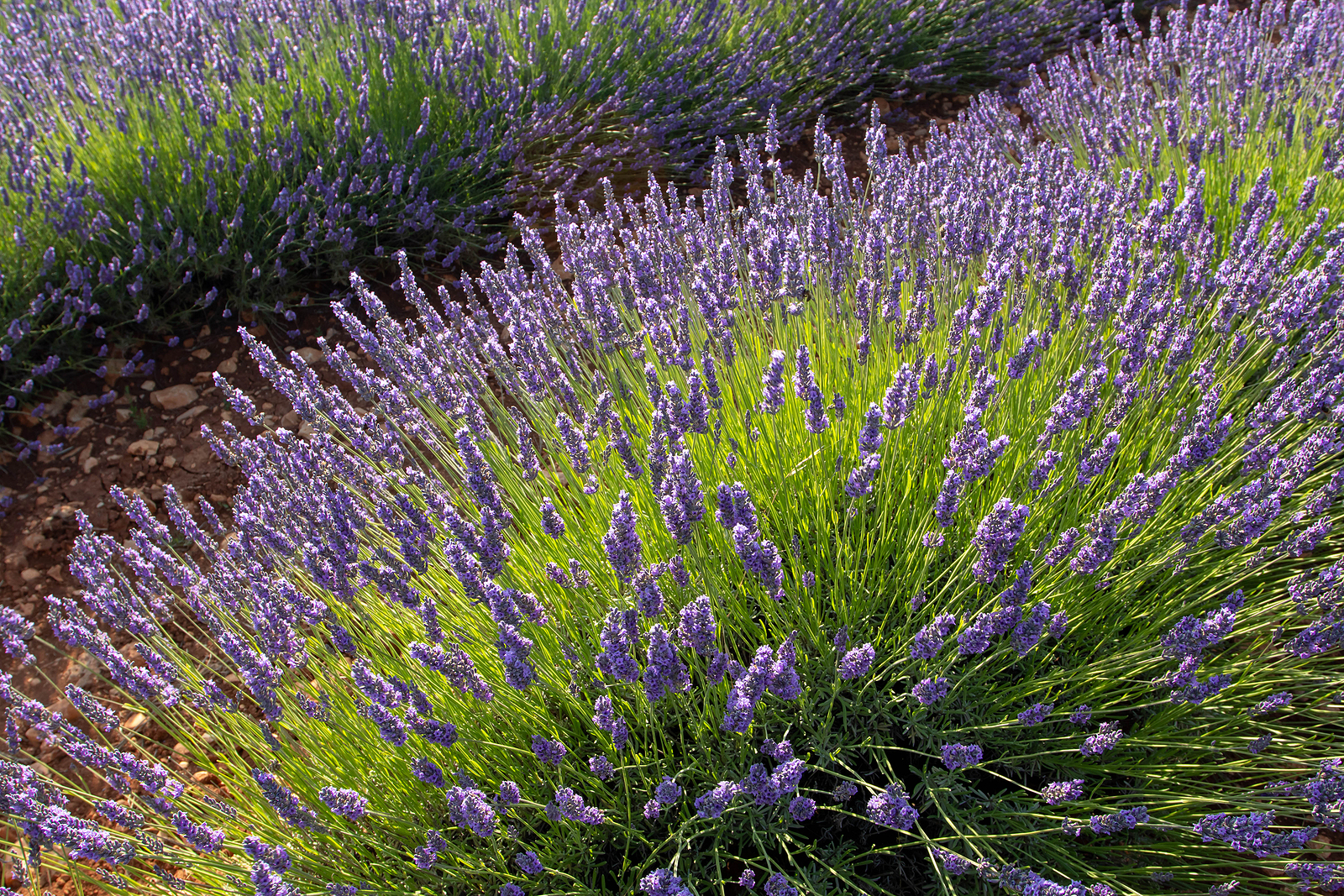 Lavandula angustifolia ‘Munstead’ produces blue-purple flowers on plants to 18 inches (45cm) high and 24 inches (60cm) wide. This is an English lavender that grows compact and bushy with linear, gray-green leaves. Blooms appear in dense spikes and come in mid and late summer on long, unbranched stalks. Once established this plant requires little water. Grow English lavenders in Zones 5-9.
Lavandula angustifolia ‘Munstead’ produces blue-purple flowers on plants to 18 inches (45cm) high and 24 inches (60cm) wide. This is an English lavender that grows compact and bushy with linear, gray-green leaves. Blooms appear in dense spikes and come in mid and late summer on long, unbranched stalks. Once established this plant requires little water. Grow English lavenders in Zones 5-9.
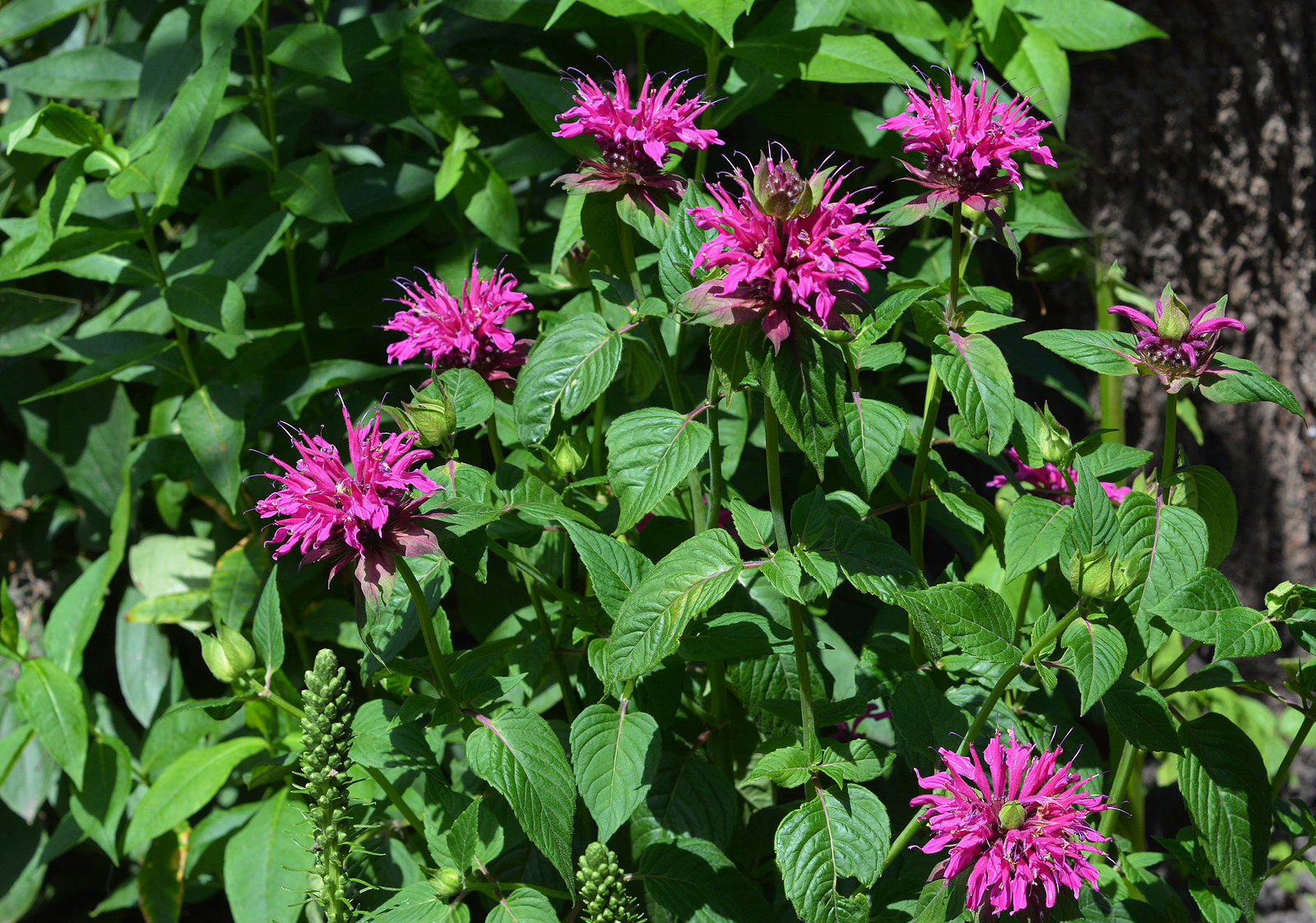 Monarda didyma—commonly called bee balm–is one of the few herbs with showy blossoms. Flowers can be bright red, salmon, pink, burgundy, or white; all attract bees and hummingbirds to the garden. Flowers appear in clusters atop 3-to-4-foot stems. Monarda is a beautiful addition to perennial borders and cottage gardens. The aromatic lance-shaped leaves also are the flavoring in Earl Grey tea. Grow Monarda in full sun to part shade. It wants humus-rich soil and regular water. Monarda grows best in Zones 4 to 9. Check out the cultivar the ‘Cambridge Scarlet.’
Monarda didyma—commonly called bee balm–is one of the few herbs with showy blossoms. Flowers can be bright red, salmon, pink, burgundy, or white; all attract bees and hummingbirds to the garden. Flowers appear in clusters atop 3-to-4-foot stems. Monarda is a beautiful addition to perennial borders and cottage gardens. The aromatic lance-shaped leaves also are the flavoring in Earl Grey tea. Grow Monarda in full sun to part shade. It wants humus-rich soil and regular water. Monarda grows best in Zones 4 to 9. Check out the cultivar the ‘Cambridge Scarlet.’
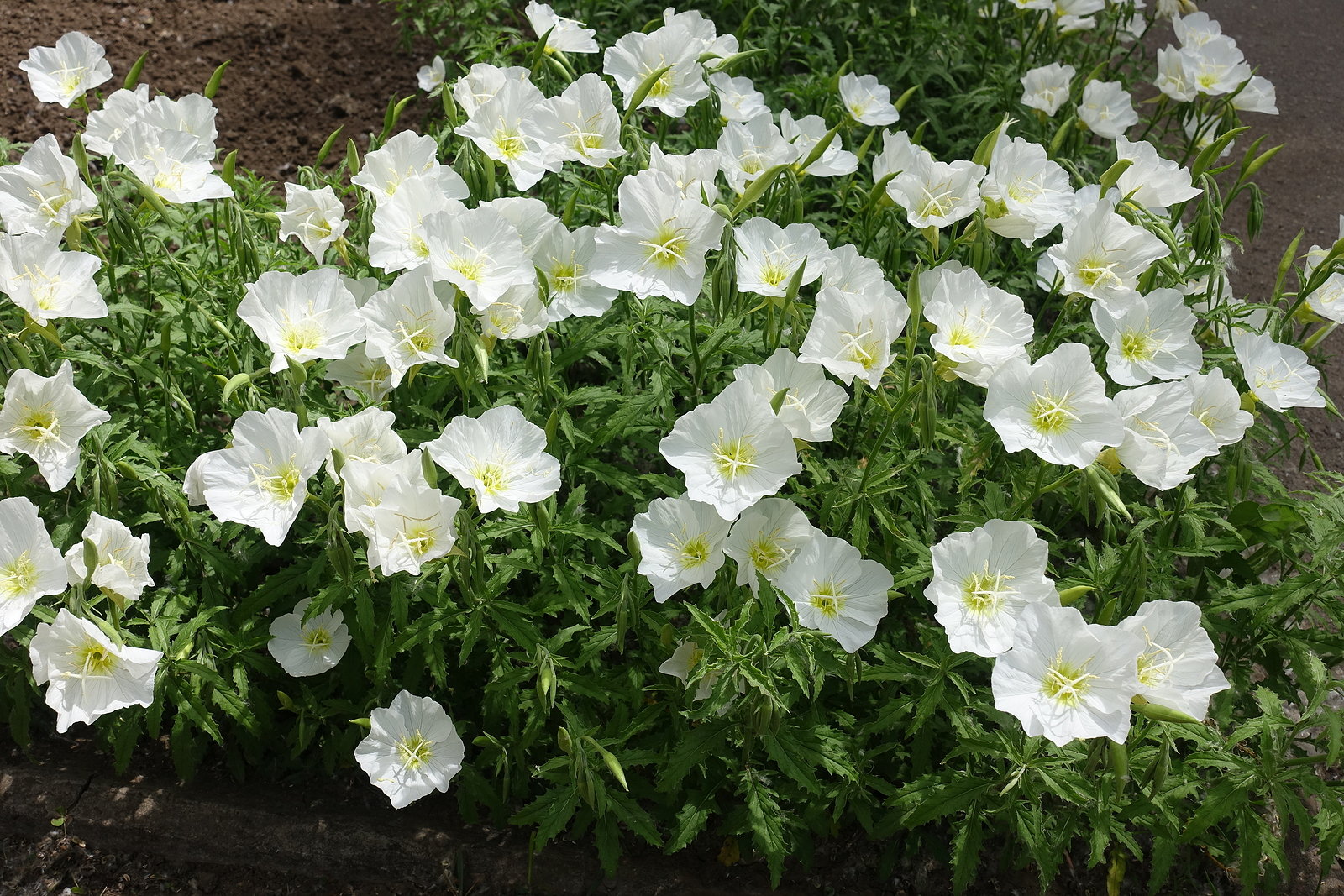 Oenothera speciosa–commonly called evening primrose or sundrops– is a short-lived, clump-forming perennial with fragrant, saucer-shaped pure white flowers that age to pink. Leaves are spoon-shaped and deeply cut. Some Oenothera opens in the late afternoon and closes the following morning. Some blossom during the day. Oenothera blooms best in full sun but can withstand light shade. All flowers fade quickly. Sow seed in late spring or midsummer. Oenothera is a perennial that grows from 18 to 36 inches tall; it spreads via underground roots. Plant Oenothera in mixed borders or along border edges. Oenothera grows best in Zones 3 to 9. Also, check out Oenothera tetragonal ‘Fireworks.’
Oenothera speciosa–commonly called evening primrose or sundrops– is a short-lived, clump-forming perennial with fragrant, saucer-shaped pure white flowers that age to pink. Leaves are spoon-shaped and deeply cut. Some Oenothera opens in the late afternoon and closes the following morning. Some blossom during the day. Oenothera blooms best in full sun but can withstand light shade. All flowers fade quickly. Sow seed in late spring or midsummer. Oenothera is a perennial that grows from 18 to 36 inches tall; it spreads via underground roots. Plant Oenothera in mixed borders or along border edges. Oenothera grows best in Zones 3 to 9. Also, check out Oenothera tetragonal ‘Fireworks.’
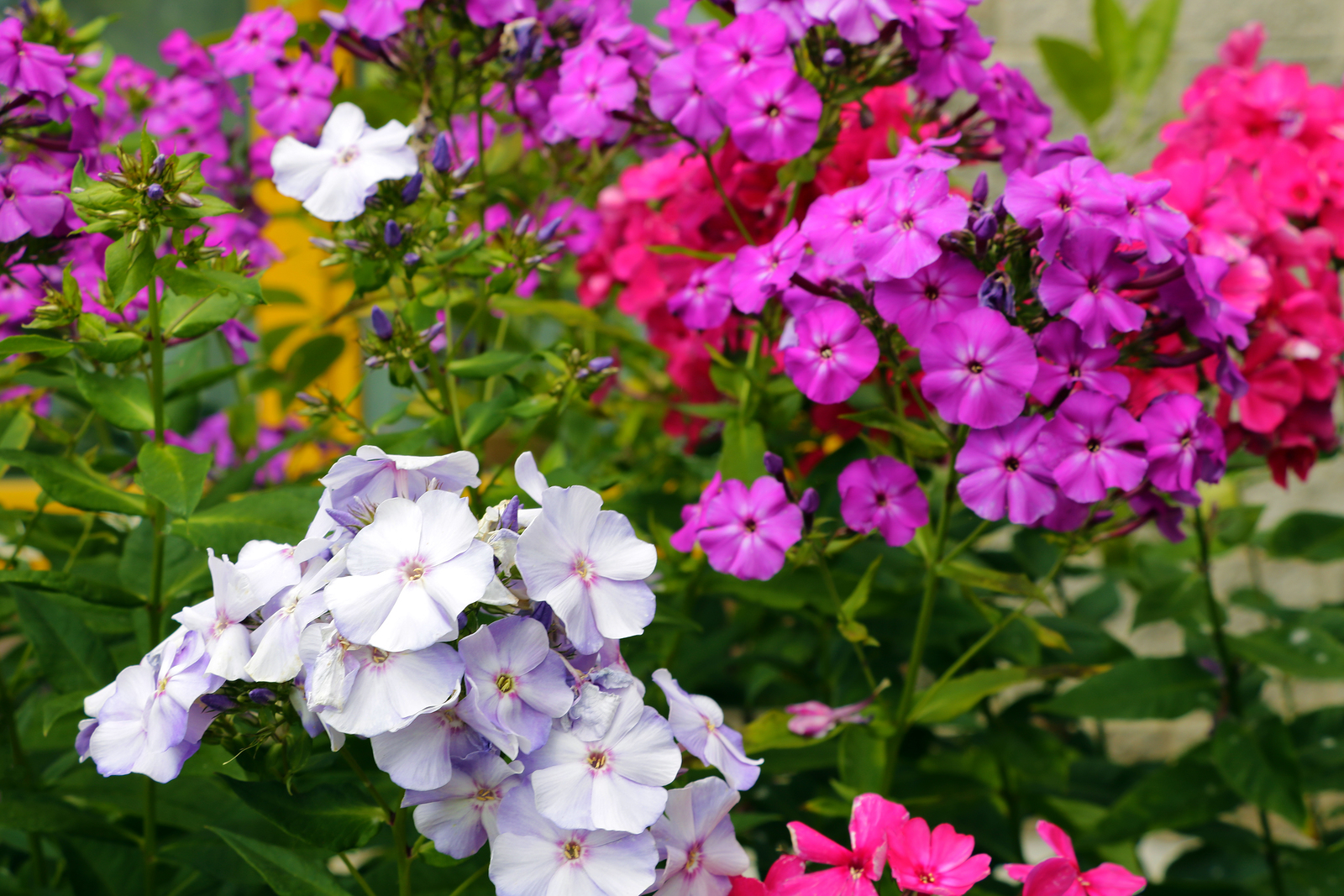 Phlox paniculata, summer phlox. There is almost a phlox for every season (except winter). Summer phlox continues to bloom into autumn, all the way to the first frost. Summer phlox thrives in full sun, except in hot regions where partial shade will protect phlox from the sun which can bleach the color out of the blooms. Summer phlox grows 3 to 5 feet (.9-1.5m) high and 2 feet (.6m) wide. Colors include white and shades of lavender, pink, rose, and red. They are susceptible to mildew if not given good air circulation—don’t crowd them. Phlox grows well in Zones 3 to 9. Add summer phlox to beds and borders; it also grows well in containers. Try the cultivar ‘Mt. Fuji’ are white, long-blooming, and mildew resistant.
Phlox paniculata, summer phlox. There is almost a phlox for every season (except winter). Summer phlox continues to bloom into autumn, all the way to the first frost. Summer phlox thrives in full sun, except in hot regions where partial shade will protect phlox from the sun which can bleach the color out of the blooms. Summer phlox grows 3 to 5 feet (.9-1.5m) high and 2 feet (.6m) wide. Colors include white and shades of lavender, pink, rose, and red. They are susceptible to mildew if not given good air circulation—don’t crowd them. Phlox grows well in Zones 3 to 9. Add summer phlox to beds and borders; it also grows well in containers. Try the cultivar ‘Mt. Fuji’ are white, long-blooming, and mildew resistant.
 Physostegia virginiana–commonly called obedient plant–bears spikes of hooded, two-lipped, tubular white, pink, or purple flowers. Blooms appear in late summer. When moved, the flowers will remain in the new position–thus the common name obedient plant. Obedient plant is a compact, erect perennial with lance-shaped, toothed mid-green leaves. Physostegia grows 20 to 36 inches (50-91cm) depending on the variety. It wants full to half sun and average well-drained soil. Physostegia is an aggressive spreader so dividing plants every two years is a good idea. Physostegia tolerates both heat and humidity. It grows best in Zones 2 to 9.
Physostegia virginiana–commonly called obedient plant–bears spikes of hooded, two-lipped, tubular white, pink, or purple flowers. Blooms appear in late summer. When moved, the flowers will remain in the new position–thus the common name obedient plant. Obedient plant is a compact, erect perennial with lance-shaped, toothed mid-green leaves. Physostegia grows 20 to 36 inches (50-91cm) depending on the variety. It wants full to half sun and average well-drained soil. Physostegia is an aggressive spreader so dividing plants every two years is a good idea. Physostegia tolerates both heat and humidity. It grows best in Zones 2 to 9.
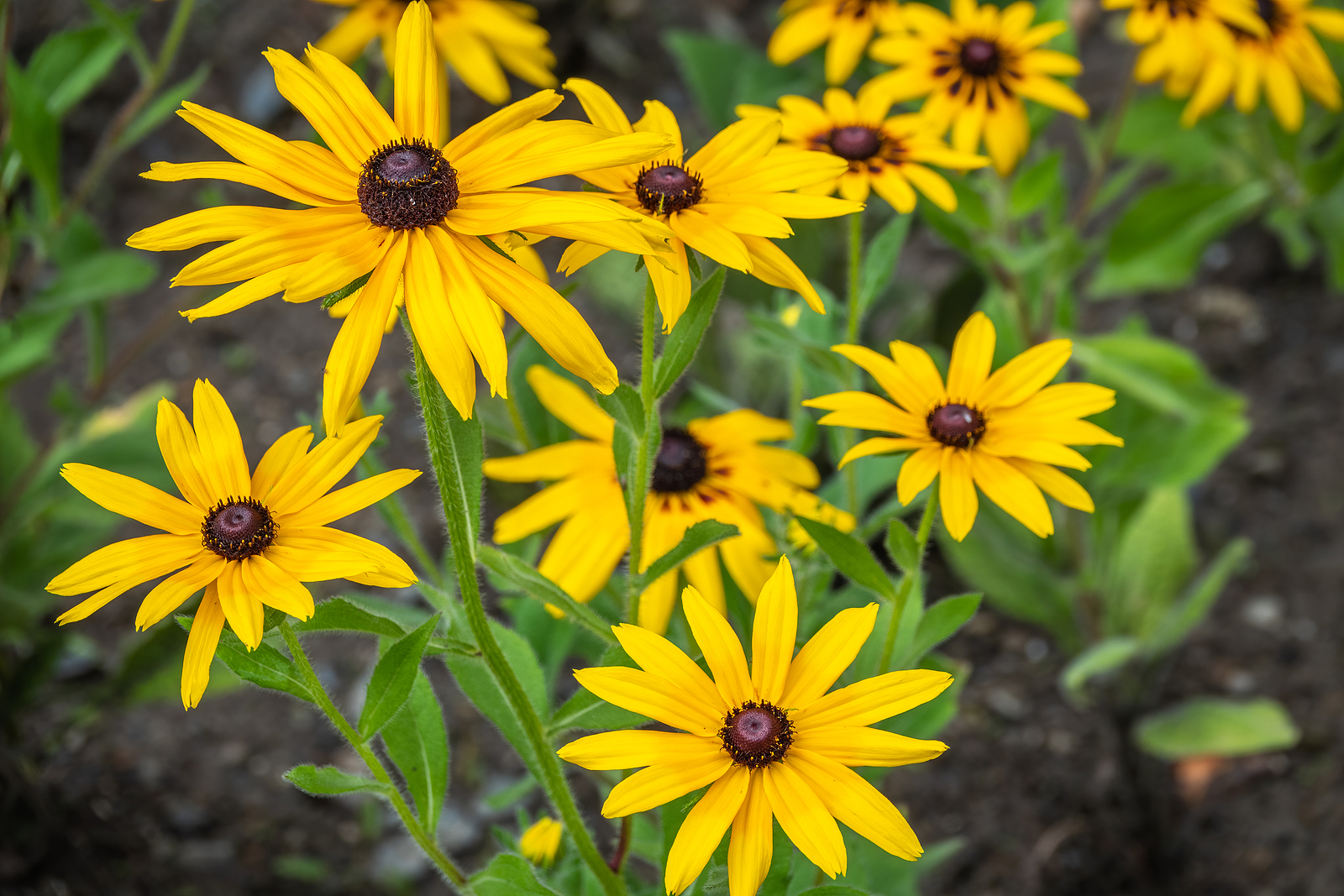 Rudbeckia fulgida ‘Goldsturm’–commonly called orange coneflower–is a hardy perennial that blooms from midsummer to fall. Golden orange ray petals surround a raised, dark brown cone. The daisy-like flowers are 3 inches across. The broad, pointed leaves are green with a smooth texture. Orange coneflower grows 2 to 3 feet (1m) tall and spreads to form 1- to 3-foot clumps. Full sun is best for Rudbeckia fulgida; it will grow in average soil. Grow orange coneflower in Zones 3 to 9; this plant thrives in heat and humidity.
Rudbeckia fulgida ‘Goldsturm’–commonly called orange coneflower–is a hardy perennial that blooms from midsummer to fall. Golden orange ray petals surround a raised, dark brown cone. The daisy-like flowers are 3 inches across. The broad, pointed leaves are green with a smooth texture. Orange coneflower grows 2 to 3 feet (1m) tall and spreads to form 1- to 3-foot clumps. Full sun is best for Rudbeckia fulgida; it will grow in average soil. Grow orange coneflower in Zones 3 to 9; this plant thrives in heat and humidity.
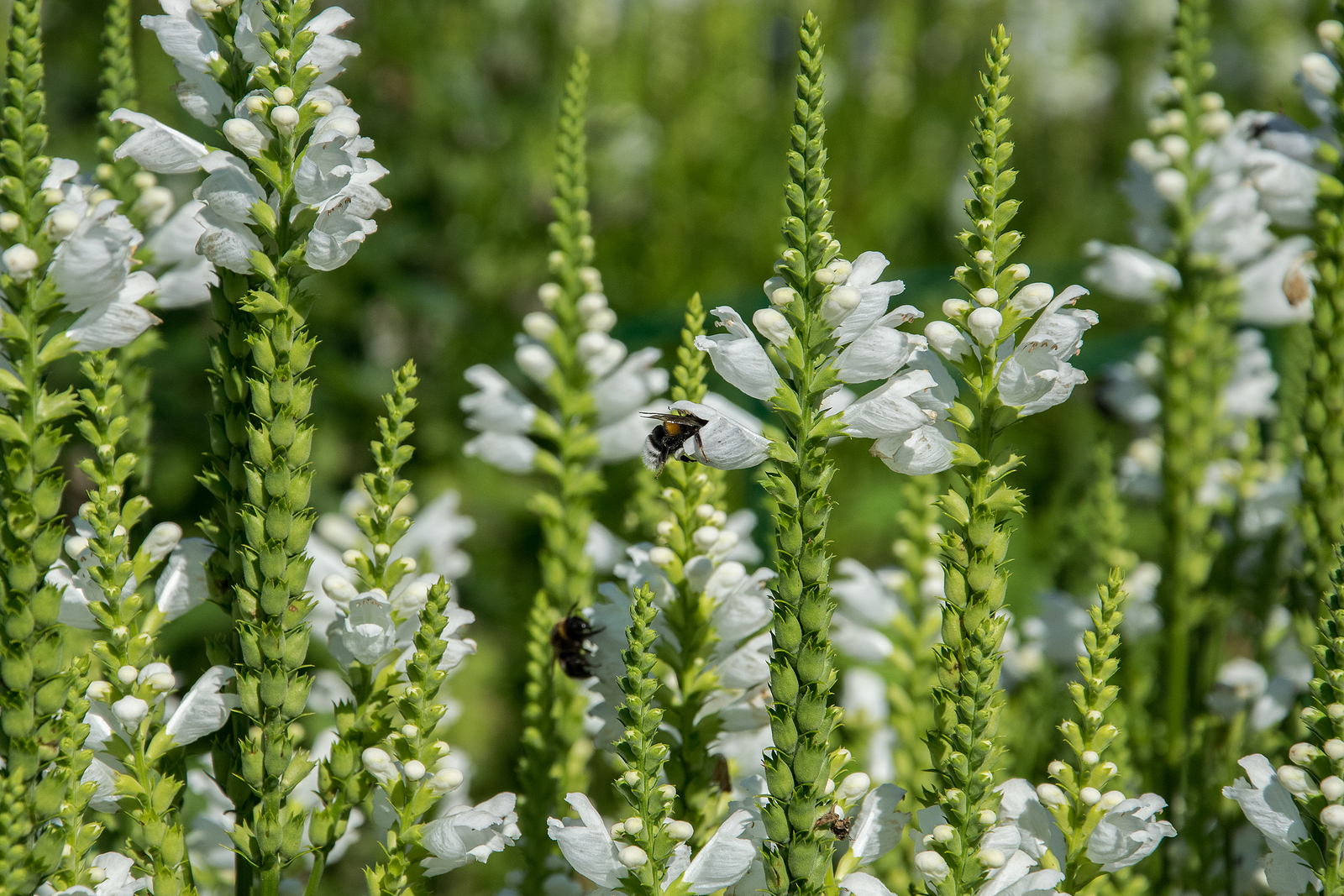 Veronica spicata—commonly called speedwells—is a vigorous, easy-to-grow perennial with a rich palette of colors including true blue, violet-blue, pink, and white. Flower spikes are bottlebrush-like with individual blooms ½ inch or less across. Most are upright growers but there are a few species that are low-growing and mat-forming. Flowers appear in spring and early summer. Veronica grows 6 to 20 inches (15-50cm) tall and spread 3 to 4 feet (1-1.2m) wide. Veronica grows best in full sun and will tolerate half shade. Grow Veronica in average to slightly acid, well-drained soil. Veronica grows best in Zones 3 to 8. Look for hybrid cultivars ‘Blue Peter’ and ‘Icicle.’ Also Veronica longifolia ‘Lavender Charm.’
Veronica spicata—commonly called speedwells—is a vigorous, easy-to-grow perennial with a rich palette of colors including true blue, violet-blue, pink, and white. Flower spikes are bottlebrush-like with individual blooms ½ inch or less across. Most are upright growers but there are a few species that are low-growing and mat-forming. Flowers appear in spring and early summer. Veronica grows 6 to 20 inches (15-50cm) tall and spread 3 to 4 feet (1-1.2m) wide. Veronica grows best in full sun and will tolerate half shade. Grow Veronica in average to slightly acid, well-drained soil. Veronica grows best in Zones 3 to 8. Look for hybrid cultivars ‘Blue Peter’ and ‘Icicle.’ Also Veronica longifolia ‘Lavender Charm.’
Also of interest:
Ten Autumn Blooming Perennials















